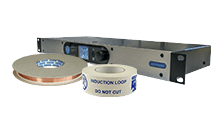BS 8300: What It Means for Assistive Listening
For people with hearing loss, navigating public spaces can often be an isolating experience. Imagine stepping into a busy train station, a conference hall, or even a small community centre only to find that essential announcements or conversations are out of reach. While assistive listening technology has existed for decades, many buildings still fall short in offering effective, inclusive solutions.
Understanding BS 8300 and Its Impact
BS 8300 is the UK’s standard for designing accessible and inclusive environments. It is split into two parts:
- BS 8300-1 focuses on the design of the external built environment, such as approaches to buildings, parking facilities, and public spaces like transport hubs or streetscapes.
- BS 8300-2 addresses the design of buildings and their interiors, offering practical guidance on layouts, fittings, and features that support accessibility inside spaces like lecture halls, meeting rooms, and reception areas.
Together, these standards are essential for architects, planners, facilities managers, and developers who are responsible for creating environments that are accessible to all. For assistive listening, they offer clear expectations on where and how systems should be implemented—well beyond simply ticking a compliance box.
This includes everything from lecture theatres to ticket counters, where access to clear audio is essential for inclusion. BS 8300 reflects the importance of integrating accessibility from the very start of the design process, not treating it as an afterthought.
Bridging the Gap: The Role of Assistive Listening
Consider a university lecture hall. A student with hearing loss, Sarah, sits in the middle of the room, straining to follow the lecturer’s words. While captions or sign language interpreters may support some, many rely on hearing loops, infrared systems, or Auracast™ solutions to access audio clearly and directly.
BS 8300 helps ensure that these systems are recognised as fundamental components of an inclusive environment—not optional add-ons.
Highlights of the Standard
Clear Guidance for Implementation
BS 8300 outlines where assistive listening systems should be installed, from service counters and meeting rooms to theatres and transport hubs. It promotes best practices for coverage, signage, and accessibility, ensuring users can easily identify and connect to available systems.
Focus on the End-User Experience
Installation alone isn’t enough. The standard reinforces the need for routine maintenance, functional checks, and staff training to ensure systems work reliably when someone needs them.
Adapting to Emerging Technologies
While hearing loops remain a cornerstone, BS 8300 also encourages the consideration of newer technologies like Auracast™, Audio over Wi-Fi, and Bluetooth LE Audio, which offer improved flexibility and compatibility with modern personal devices.
What This Means for Architects and Building Managers
For those responsible for designing or maintaining public spaces, BS 8300 offers a comprehensive framework for creating environments that are not only compliant but truly inclusive.
Following this guidance ensures that buildings support everyone—whether it’s a student like Sarah, an elderly commuter trying to hear announcements, or a museum visitor using an audio guide.
Because at its core, assistive listening isn’t just about tech.
It’s about connection, dignity, and equal access.



